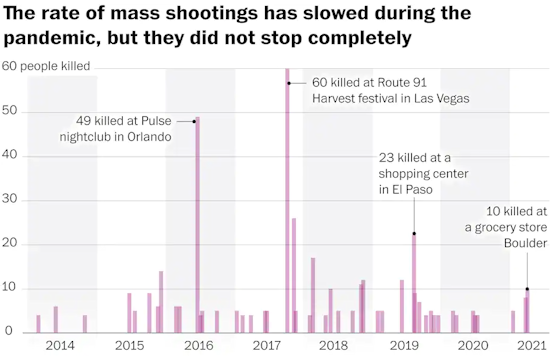|
More than 100 Americans a
Day Are Murdered
2020 was the deadliest gun violence year in
decades
Shootings never stopped during the pandemic
Until two lethal rampages this month, mass shootings had largely been absent
from headlines during the coronavirus pandemic. But people were still dying — at
a record rate.
In 2020, gun violence killed nearly 20,000 Americans, according to
data
from the Gun Violence Archive, more than any other year in
at least two
decades. An additional 24,000 people died by suicide with a gun.
The vast majority of these tragedies happen far from the glare of the national
spotlight, unfolding instead in homes or on city streets and — like the covid-19
crisis — disproportionately affecting communities of color.
Last week’s shootings at
spas in the Atlanta area and Monday’s shooting at
a grocery store in Boulder, Colo., killed a combined 18 people and
rejuvenated a national effort to overhaul gun laws. But high-profile mass
shootings such as those tend to overshadow the instances of everyday violence
that account for most gun deaths, potentially clouding some people’s
understanding of the problem and complicating the country’s response, experts
say.
&uuid=(email))
Shooting deaths in 2020 outpaced the next-highest recent year, 2017, by more
than 3,600. The rise resembles other alarming trends: Last year, the United
States saw
the highest one-year increase in homicides since it began keeping records,
with
the country’s largest cities suffering a 30 percent spike. Gunshot injuries
also rose dramatically, to nearly 40,000, over 8,000 more than in 2017.
“More than 100 Americans are killed daily by gun
violence,” Ronnie Dunn, a professor of urban studies at Cleveland
State University, said, using a figure that includes suicides. “The majority are
in Black and Brown communities. We don’t really focus on gun violence until we
have these mass shootings, but it’s an ongoing, chronic problem that affects a
significant portion of our society.”
Researchers say the pandemic probably fueled the increases in several ways.
They also note the apparent collapse of public confidence in law enforcement
that followed
the police killing of George Floyd in Minneapolis.
Covid-19 and the protests over police brutality also led to
a surge of firearm sales. In 2020, people purchased about 23 million guns, a
64 percent increase over 2019 sales, according to a Washington Post analysis of
federal data on gun background checks.
Dunn pointed to this flood of firearms as the most detrimental factor in the
fight to curb gun violence. When shootings become “the soundscape of inner-city
neighborhoods,” he said, “it increases anxiety and stress and creates toxic
stress.” Dunn compared the effect to post-traumatic stress disorder akin to what
war veterans experience.
Nearly 300 children were shot and killed in 2020, according to Gun
Violence Archive data, a 50 percent increase from the previous year. More
than 5,100 kids and teens 17 and younger were killed or injured last year — over
1,000 more than any other year since 2014, when the website began tracking it.
The increase is especially striking because it occurred in a year when most
children weren’t attending class in person and were spared deadly school
shootings. Experts say it highlights the severity of suicide and domestic
violence.
Even though the rate of mass shootings slowed last year, several occurred before
the killings in Atlanta and Boulder, according to The Post’s
public mass shootings database.
On average, there was one mass shooting every 73 days in 2020, compared with one
every 36 days in 2019 and one every 45 days in 2017 and 2018. The slowdown
interrupted what had been a five-year trend of more frequent and more deadly
mass shootings.
washingtonpost.com

|